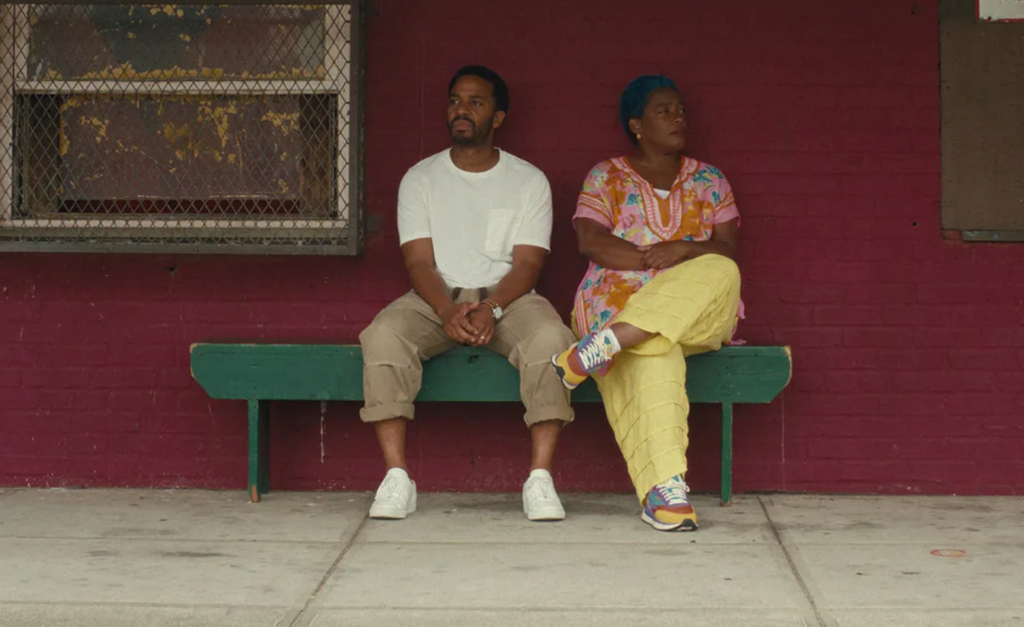
Born and raised in Southern California, Catalina is a freelance…
Exhibiting Forgiveness is a masterful piece of work. The film premiered at Sundance in the Eccles Theater to a sold-out crowd, and congratulated with a roaring standing ovation. Director and writer Titus Kaphar has set the bar high with this directorial feature debut. Exhibiting Forgiveness is what cinema should be when everything is firing on all cylinders from location and story to cast and cinematography. It’s a beautiful piece of art, which makes sense since it comes from an American contemporary painter whose work has reshaped art history and representation.
Exhibiting Forgiveness follows Tarrell, played by André Holland (Moonlight, Castle Rock), a successful artist, whose paintings have been getting rave reviews. Tarrell is enjoying his success and looking forward to spending more time with his wife (Andra Day) and young son. He also has plans to move his mother (Aunjanue Ellis-Taylor) in with them. But, those plans are derailed when his estranged father, a homeless, recovering crack addict, comes back into his life hoping to patch things up now that he’s clean. Tarrell is plagued with night terrors and traumatic memories of his childhood as he tries to navigate his feelings and protect his family from future trauma.
A trigger warning should be mentioned before viewing Exhibiting Forgiveness. The film centers on heavy topics surrounding abuse, trauma, and drug addiction. This review discusses these as well.

The film boasts a phenomenal cast. Holland gives a masterclass on acting. He has the remarkable ability to express multiple emotions with just a look. Ellis-Taylor is a powerhouse whose emotions radiate across the screen. She makes you feel what she is feeling. The scenes with these two are so powerful and dynamic. This is also a testament to the characters that Kaphar has written. These are multidimensional people with rich layers and an even richer history. You don’t see everything they went through, but you can feel it and see it through these actors.
It is interesting to note that this film started as a documentary. But, Kaphar decided to pivot and “cover memories with fiction so it felt safe to tell the story,” he says during the post-screening Q&A. This could be why the dialogue and interactions feel so authentic. The chemistry between Holland and Day is fantastic as well. This is what a healthy, adult marriage/relationship can look like!? I want it.
The story and character arc were A+. Exhibiting Forgiveness is a film about fathers and sons, mothers and sons, husbands and wives, dysfunctional families, and most importantly, generational AND intergenerational traumas and attempts to break those cycles. We see Tarrell actively trying to provide a different life for his son and wife than he had. For those who may not know, generational trauma is trauma that can affect future generations and impact the choices they make, how they feel, their relationships, and how they act. Intergenerational trauma can affect the health and overall well-being of future generations and the communities that form around them.

The film highlights how complex family relationships can be and how complex generational trauma can be. There’s never an easy solution and forgiveness is messy and hard. It’s an intricate web of understanding the issue, preventing, and treating the root issues. Exhibiting Forgiveness is honestly a therapy session that I immediately wanted to invite my family to.
The pacing of this story seemed very intentional. There is so much trauma and emotion being conveyed that the film gives you a moment, a beat, to pause and catch your breath and resonate with what you are feeling. It’s almost like the film provided a safe space for the audience to gather themselves. There were moments when I was actively listening and watching the film, but at the same time internalizing my own moments of trauma. This dual action happened most unexpectedly, making Exhibiting Forgiveness something raw, emotional, and just, really special. Tears were shed.
Exhibiting Forgiveness dives into the use of art as a release and healing tool. It portrays the idea of confronting your memories. Bad memories can be so saturated that it hides the good memories. In the film, Tarrell uses art as a way to confront his childhood. As the film progresses, he uses it to deal with adulthood and move on. The film highlights how valuable art can be. The film itself is a testament to that value. It’s not a cure-all, but a tool to assist in that release.
This film is not your typical happy ending, hooray, we fixed our problems film. I can say I loved this film, but I didn’t leave the theater feeling jolly. I left wanting to journal my thoughts outside of this review. I left thinking about how real the film seems. It’s a think piece for sure, as well as a beautiful and artistic creation.
Born and raised in Southern California, Catalina is a freelance journalist and film critic. You can also find her work on blackfilm.com and documentary.org. She has moderated and served on film panels, interviewed casts and crews of various films, and has been a juror for the New Orleans Film Festival. Catalina is a member of numerous critics' associations, including the Critics Choice Association, African American Film Critics Association, the Online Association of Female Film Critics, and the Hollywood Creative Alliance, as well as a Rotten Tomatoes-approved critic.









